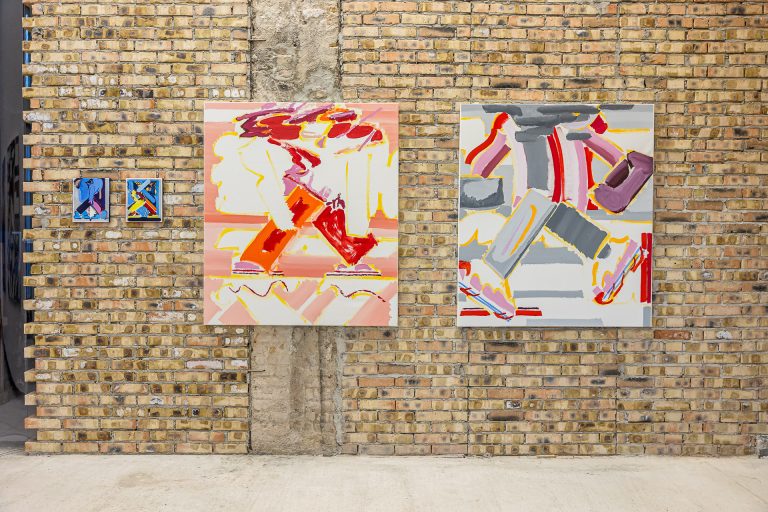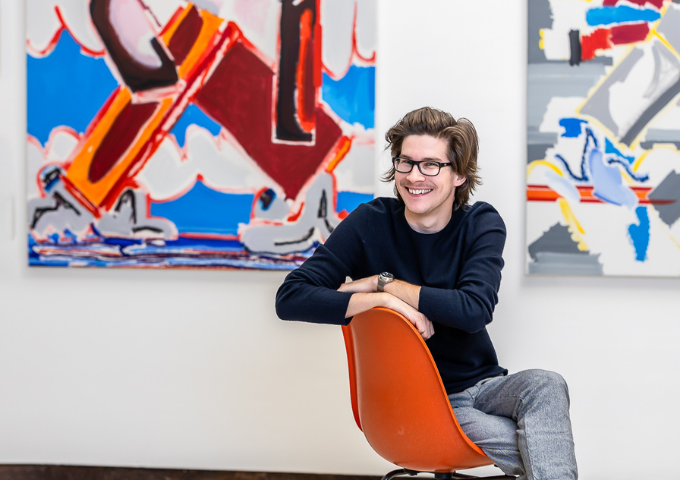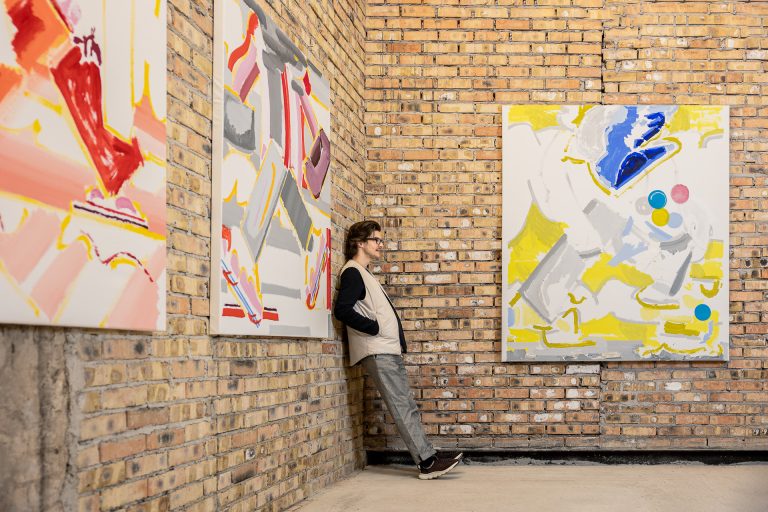Ádám Dóra, a young contemporary artist whose work is also featured in the MNB collection, has seen his career receive new impetus this year, enhanced by opportunities to work in residency programmes in Barcelona and Austria. Currently, a selection of his new series is on display at Einspach Fine Art & Photography, and we spoke with him on this occasion.
In 2020, you won a special prize in a competition in San Francisco. In 2021, you were the youngest nominee for the Esterházy Art Award and were shortlisted for the Esterhazy NOW contemporary collection, as well as for the Strabag Art Award in 2022 and 2023. The MNB collection has purchased several paintings from you. I think this list marks a quantum leap in your career. What is your inner experience of this?
Right now, I’m especially happy to have an exhibition in one of the most important galleries, which was opened by Róbert Alföldi, moreover I’m also included in his own collection. This is certainly a significant milestone in my personal artistic career, but more importantly, I think, my painting, which is what it’s all about, has reached a new stage.

What you do is absolute painting, challenging the limits of classical painting, while we are deep in the age of installations, new media, digital art and post-digital art. What does painting mean to you?
Painting is the single most important thing in my life. The fact is, that it’s the most perfect medium for me to express all the visions that form within me; to express the way I see the world. I can show all this by the sensitivity factor with which I perceive reality around me. Painting was partly a conscious choice, partly an instinctive impulse – somehow it was clear to me from the beginning that it should be painting and nothing else.
For me, the human movement, the personal nature of contemplation and perception, the way in which the view matures into a vision are extremely important. Then, as the material is being moved, the view acquires a new substance and something else is born; a creative act produces an „image object” that always has a personal aspect. Movement and dynamism are fundamental compositional elements in my new works, they have been present from the very beginning, but are somehow even more pronounced now. The power of the traceable movements on the canvas acts as a compositional organising principle. The title of the exhibition, „Working with my body”, refers to this as well. I talk about materiality, physicality, while my own body acts as a medium in the creation of the paintings. My paintings give a little taste of figurative art, referring to subjects figured and non-figured, hinting at piles of clothes, textiles, food and textures from gastronomy. A system appears in the picture, the stains and patches enter into dialogue, references appear and one can move towards a variety of valid interpretations. It is an expressive, abstract painting language that is essentially free, while I continue to think in constructed, composed images.
You started painting sneakers during Covid, it was your fashion-fuelled series titled Chunky Steps, and then it evolved into your current work. What does fashion mean to you?
The starting point for my current artworks is the experience that has matured over these five years from my familiarity with the fashion trade and my passion for cooking into sensual experiences and painting visions. Working in the fashion industry has given me a thorough knowledge of textiles, but I am only interested in fashion as a painter. The motifs of men’s clothing crept into my paintings, because I was deeply absorbed by extreme colours, shapes, the way dialogues start between them, and how all this permeates our everyday lives. And let’s not forget the role of clothing itself in our cultural history. It is also obviously part of the „degenerate” consumer culture, but as a contemporary painter I am talking about other aspects of fashion. It is about sensuous effects and the painter’s contemplation. The mundane, but very contemporary and very „up to date” subjects have become transformed into their substance thanks to the sensitive painting techniques.
You seem to be working a lot lately.
A great deal. The way my life turned out, I have been on my own for long periods lately. Painting is a solitary activity, so it was actually useful for my art, I kept painting the whole time. I spend long periods in the studio figuring out images; the artwork matures and becomes clear when I spend plenty of time with it.
I took part in two residency programmes, at the second of which, in Künstlerstadt Gmünd, Austria, I spent two months in almost complete solitude in the mountains, in a small town of 3-4 streets, where I barely met anyone from my age group. During this time, I made a serious internal journey and painted a large number of pictures.

It is interesting that before this residency you had been in Barcelona, a bustling coastal city, an important European arts centre – how did that affect you?
I spent long periods of time alone in Barcelona, too. It’s true that I have friends there, and I arrived in an active professional community, but at a time when everyone was on holiday. In August, I spent three and a half weeks out of five all alone at the Centre d’Art Contemporani in Piramidón. I found out about this residency programme by browsing the internet. I was attracted by the work of several artists working there, I applied for a place and I got it. I received a warm welcome, I fitted the profile of the place. Next year I will go back for five months, from April to August.
Do these residency programmes play a role in the breakthroughs you are seeing in your work?
I am sure of it. You can get lost in art, especially in painting. I don’t know if it’s luck or the journey of self-discovery, but the pictures are testimony to the fact that I have found a system of movement and a relationship with the material that I can use to transmute its susbtance while staying authentic and true to myself. There are many crossroads and a million facets to the process, but there is an inner core to this story that is very difficult to verbalise. The depth of the images comes out when you spend a really long time with them, keep looking at them, and the residency programmes give you the opportunity to do this immersion.
We are already half-living in a virtual reality, and that’s why it makes sense to create such paintings. I only see the justification for painting today if it has a strong relationship with materiality.
I also know that these pictures would not be made if I had no doubts or questions. Then all this would just be decoration. I figure these pictures out carefully, from their size to the stretcher; how it will work in space, how I’m going to paint the surfaces, where the slips should be, where it doesn’t quite reach the frame or where the picture will tilt. And then there is the randomness factor.
The Central Bank has also bought paintings from you from a previous series, six paintings from Natura Architectura. What is the series about?
Since the beginning of my career, I have been interested in basic contrasts: the boundaries between the natural and the artificial, the planned and the accidental, the abstract and the figurative. There’s always a line, where sooner or later things go one way or the other. Natura Architectura is about the borderline between the built environment and nature. The method of creation has been the same throughout my career, i.e. real sights and experiences, contemplative existence, observing everyday life that has matured into visions and from them images were born.
I sense that you are very curious about the world, you read a lot, you research, you keep yourself well informed.
I try to read everything I’m interested in, but I look at albums and artists online maybe even more; I go to exhibitions a lot, especially when I’m abroad, but I also try to see as much as I can here in Hungary.
I saw Daniel Richter’s exhibition in Venice last year, and it really struck me. I don’t think I necessarily do the same thing, but in many ways – in the use of materials, in the composition – it is similar. Loose but very sensual, ambivalent things meet on his canvases. I kept looking at the works of André Butzer and Albert Oehlen.
Obviously, there is plenty hidden in these works, but I consciously refrain from expressing an opinion, from discussing politics, because I am not competent, and it is not my job. These image objects feed off our lives, our days, but they become detached from it and function as a world in their own right.
There are really two kinds of curiosity. One prompts the need to be informed, to turn towards the outside world, towards peers, other areas of culture, fashion, gastronomy, design.
The other kind of curiosity is looking inward. In fact, the two come together in my paintings, and that’s probably the best way to cover everything I’m interested in. My works are a synthesis of these two things. I’m interested in systems of relationships, colours, shapes, and how many different things they can refer to, how many different things they can touch. It’s the same with cooking, where you manipulate natural ingredients until you create something edible and new flavours.
Talking so much about painting, another question came to mind: in the age of prints, reproduction and digitalization, what is our relationship to painting? I can also read your paintings as a statement saying that painting does have a place, a role, a right to exist in contemporary art. What do you think about this?
One lives and moves, touches things, senses and leaves a mark. I make paintings because I think it is not less important, but increasingly important, to create such objects. In this sense, it is indeed a rebellion or a declaration that I care about human gestures, human movements, the kind of sensitivity that is a deep aspect of existence. However much I am concerned with contemporary art and the issues of our time, there’s a very ancient element to my painting that points beyond the age we live in.

There is a very archaic, permanent, ancient layer to our existence as well. How do you create? What is the process by which such a painting is created?
Outside of my close circle of friends, I have a broader group of people I enjoy spending time with. I find it energizing when we discuss art and culture, as well as share aspects of our personal lives. While doing this, I take phone photos, draw sketches on paper, and the composition takes shape in my head. When I start a picture, there are no more aids. I paint from my head, after I’ve figured out the image and put the vision together. This is probably also the result of the fact that I come from an academic art education, I can draw from sight, I know what to mix with what, what tools and materials to use, I can remix any colour I have used with total confidence, even after a long time.
I love the physical act of creating my paintings just as much as the mental process behind them. The two go hand in hand. Everything works out when it all has a nice rhythm, a steady swaying flow. There are days and periods when I’m just thinking, taking notes, figuring things out and burning things into my retina, but when that’s over, I have paint all over me from morning till night for days, weeks, and I enjoy being completely immersed in the material and working with it.
How do you know when it’s complete? How long does it take to finish such a picture?
This is the most difficult question to answer. The best paintings take a relatively short time. You have to go deep into it, you have to bond very strongly with the material for everything to fall into place: the surfaces, the density, the brush hairs. Many things have to align, and you have to be able to conduct it in a relatively short time. While I’m painting the surface, I sit, have a coffee, flip through an album, listen to music or a podcast – and then suddenly something lines up and I paint the picture in a few intense hours.





